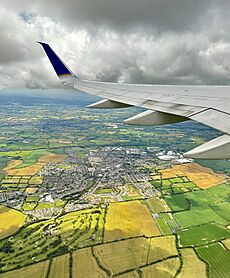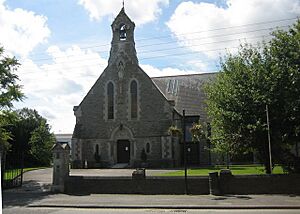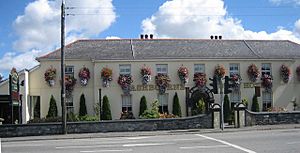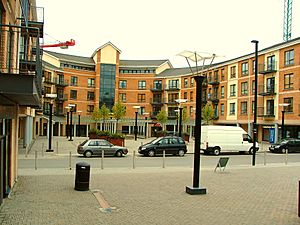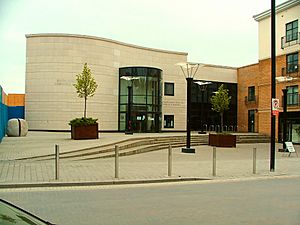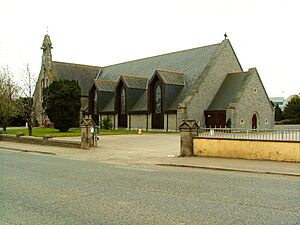Ashbourne, County Meath facts for kids
Quick facts for kids
Ashbourne
Cill Dhéagláin
|
|
|---|---|
|
Town
|
|
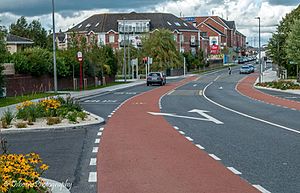
Bridge Street, Ashbourne
|
|
| Country | Ireland |
| Province | Leinster |
| County | Meath |
| Elevation | 73 m (240 ft) |
| Population
(2022)
|
15,680 |
| Time zone | UTC±0 (WET) |
| • Summer (DST) | UTC+1 (IST) |
| Eircode routing key |
A84
|
| Telephone area code | +353(0)1 |
Ashbourne (which means 'Declan's church' in Irish) is a busy town in County Meath, Ireland. It is about 20 km north of Dublin. Ashbourne is known as a commuter town. This means many people who live there travel to Dublin for work or school.
The town has grown a lot! Between 1996 and 2022, its population more than tripled. It went from about 4,900 people to 15,680. The Broad Meadow Water flows through Ashbourne.
Contents
History of Ashbourne
Early Settlements
People have lived in the Ashbourne area for a very long time. Digs by archaeologists have found signs of homes from the Stone Age (Neolithic times). In a place called Rath, north of the town, a Bronze Age settlement was found. This happened when the M2 motorway was being built.
Archaeologists also found clues about the original medieval town. They discovered old house remains, farm fields, and even fish traps. Near the Killegland cemetery, they found an early Christian settlement. This area had underground tunnels (souterrains) and house sites. This shows that people lived here even before Saint Patrick. The name Killegland means 'Declan's Church'.
The town was called Killegland or Kildeglan from the 1200s until the late 1800s.
Norman Times and Beyond
After the Normans arrived in Ireland, Hugh de Lacy, Lord of Meath, built strongholds. These were called mottes and baileys. You can still see the remains of one in Ratoath, which is 5 km from Ashbourne.
A family called Wafre was given a large part of Killegland in 1220. They lived there until 1420. The last Wafre built a tower house. This was a strong, tall house, sometimes called a "castle." Later, the Segrave family owned the castle and lands until 1649. During the time of Oliver Cromwell, his son Henry even stayed in Killeglan Castle for a while.
After 1690, a new landowner named Thomas Carter took over the Killeglan lands. He did not live there, and the castle slowly fell apart.
How Ashbourne Got Its Name
In the 1800s, roads in Ireland were not very good. Frederick Bourne was a rich businessman who made money from roads and transport. He helped build a ten-mile section of road from Dublin to Killegland.
In 1820, he decided to build a small town near his tollbooth. He wanted to make money from travelers. He built an inn, a hotel, and other small shops. He named this new village after his favorite tree, the Ash, and his own name, Bourne. That's how Ashbourne got its name!
Frederick Bourne's idea worked well at first. But by 1850, trains became popular, and fewer people used the roads. The Bourne family's money started to decrease. In 1821, Ashbourne had 133 people. By 1841, it had 411. The Irish Famine from 1845 to 1851 caused the population to drop.
Frederick Bourne left his land and the village of Ashbourne to his son Richard in 1844. Richard lived in the village. His first home is now the Ashbourne House Hotel. Later, he built a house near the old Wafre and Segrave tower houses. Richard's son, Thomas, was the last landlord of Ashbourne. He sold the land to the local people in 1899.
The 1916 Rising: Battle of Ashbourne
On April 28, 1916, a group of Irish Volunteers from Fingal attacked the Royal Irish Constabulary (RIC) police station in Ashbourne. This was part of the wider 1916 Rising. About 45 men, led by Thomas Ashe, took part.
The rebels approached the police station and disarmed two RIC officers outside. Ashe asked the other officers to give up, but a shootout began. The RIC officers eventually tried to surrender by waving a white handkerchief. However, more RIC officers arrived in cars from Slane. Ashe's group quickly moved to stop them.
The fight lasted for several hours. More volunteers arrived, and the RIC officers finally surrendered. But because the uprising in Dublin had been stopped, the Fingal volunteers also gave up two days later. Thomas Ashe and his men were sentenced to death, but their sentences were changed to life in prison.
Remembering the Battle
Seán T. O'Kelly, who was the President of Ireland at the time, opened a memorial at Rath Cross Roads in Ashbourne on Easter Sunday, April 26, 1959. This memorial remembers the Battle of Ashbourne and two men, John Crenigan and Thomas Rafferty, who were killed. The monument has two images: one looks like Christ, and the other is a rebel.
In 2016, on Easter Monday, Rath Cross was one of the places where the 100th anniversary of the 1916 Rising was celebrated. In September 2016, the monument was made bigger with two new figures. One shows a Volunteer in uniform, and the other shows a family.
Population
| Historical population | ||
|---|---|---|
| Year | Pop. | ±% |
| 1991 | 4,411 | — |
| 1996 | 4,999 | +13.3% |
| 2002 | 6,362 | +27.3% |
| 2006 | 8,528 | +34.0% |
| 2011 | 11,355 | +33.1% |
| 2016 | 12,679 | +11.7% |
| 2022 | 15,680 | +23.7% |
Ashbourne was a small village with fewer than 400 people until 1970. Then, because Dublin's population was growing, many new houses were built in Ashbourne.
The town's population has more than tripled since 1996. In 2022, 15,680 people lived there. This makes Ashbourne the second largest town in Meath, after Navan. It is also the biggest town in the Meath East area.
Ashbourne has also become more diverse. The 2006 census showed that over 12% of the people in Ashbourne were born outside Ireland. The Lithuanian community is the second largest group of people from other countries in Ashbourne. Almost one-fifth of all non-Irish born people in the town are from Lithuania. There are even church services in Lithuanian at the Church of the Immaculate Conception.
Getting Around Ashbourne
Public Transport
Ashbourne has two main public transport companies: Bus Éireann and Ashbourne Connect. Ashbourne Connect offers a fast bus service directly to Dublin city centre.
Bus Éireann also has services from Dublin. Some of these buses continue to places like Ratoath and Duleek. Other Bus Éireann routes connect Ashbourne to Blanchardstown, Drogheda, Dublin Airport, and Kells. There are also Go-Ahead routes to Balbriggan and Swords.
Roads
Ashbourne is connected to the M50 and Dublin city by a 17-kilometer motorway. This road is part of the N2/M2 national route. It starts at junction 5 of the M50 motorway. The road is a six-lane dual-carriageway for part of the way. It then becomes a motorway that goes around Ashbourne. This helps traffic move smoothly.
Shops and Fun Things to Do
Ashbourne has many shopping areas. These include shops in the crescent and on Ashbourne High Street. In 2002, a plan was made to expand Ashbourne. This plan added new homes, a retail park, community buildings, and industrial units.
Killegland Street is a main shopping street in Ashbourne's "new" town centre. It has many shops, a library, and council offices. There is also plenty of parking, including underground parking and a multi-storey car park.
A large supermarket has opened a big store in the town centre. It is easy to get to from both Frederick Street and Killegland Square.
In 2009, Ashbourne got its first cinema in the Ashbourne Retail Park.
Emerald Park is a big amusement park and zoo near Ashbourne. It used to be called Tayto Park. It opened in 2010 and has about 50 acres of fun activities. Emerald Park is home to The Cú Chulainn Coaster, which is one of Europe's largest wooden roller coasters! It opened in June 2015.
Religion
The main Roman Catholic church in Ashbourne is the Church of the Immaculate Conception. It is located in the centre of town. Since 1982, the parish has also included Donaghmore, which has its own church about 2 km south-east of Ashbourne.
Sports
Ashbourne has many sports clubs and facilities. There is an 18-hole golf course on the edge of town, which started in 1991.
The local Gaelic Athletic Association (GAA) club is called Donaghmore Ashbourne GAA. It has pitches and a clubhouse with an indoor astroturf. It also has two full-size Gaelic pitches that opened in 2006.
The local rugby union team, Ashbourne Rugby Club, started in 1976. Ashbourne is also home to the Longhorns Rugby League Club. They were All-Ireland Rugby League champions in 2017.
There are also several soccer teams, like Ashbourne United and Killegland AFC. You can find a cricket club behind the community centre and a judo club.
The community centre opened in 1981 and was updated in 2017. It has a sports hall with a full-size basketball court, three badminton courts, a squash court, and a handball court. Many sports groups use the centre.
The International Baseball Centre (IBC) is in Ashbourne. It is Ireland's only international standard baseball field. It is home to the Ashbourne Baseball Club. This club plays in the Irish Baseball League. They have teams for younger players (Little League) and for adults. Their home games are played at the IBC.
Fairyhouse Racecourse, a famous horse racing track, is only 10 km from Ashbourne.
People
- Nina Carberry, a jockey
- Peter Dempsey, a racing driver
- Johnny Logan, a singer famous for winning Eurovision
- Aengus Mac Grianna, a newsreader for RTÉ
- Daráine Mulvihill, a television presenter
- Thomas Ryan, an artist who lived and worked in Ashbourne
- Kevin Toner, a football player
See also
 In Spanish: Ashbourne (Irlanda) para niños
In Spanish: Ashbourne (Irlanda) para niños



